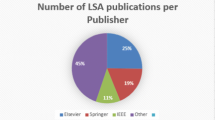Abstract
In this paper, a novel genetic algorithm assisted partial transmit sequence (NGA-PTS) is proposed to reduce the peak-to-average power ratio (PAPR) of orthogonal frequency division multiplexing (OFDM). However, the search complexity of the optimum PTS (OPTS) scheme is too large for the typical number of sub-blocks. Therefore, some artificial intelligence methods, such as genetic algorithm technique, and particle swarm optimization, are introduced to reduce the complexity. As traditional GA-PTS (TGA-PTS) technique risks finding a suboptimal solution, how to avoid this disadvantage of TGA-PTS is an interest topic. In order to obtain a better suboptimal solution, a phase factor optimal pair technique and an abandon/introduction new chromosome technique are proposed in GA here. Simulation results show that the proposed scheme achieves a significant improvement over the TGA-PTS scheme in PAPR. Furthermore, by use of the inherent diversity of constellation for each OFDM candidate, in the receiver part, the proposed scheme enables data recovery without any side information. Simulation results show the efficiency of the proposed scheme.
Similar content being viewed by others
References
Nee R V, Prasad R. OFDM for Wireless Multimedia Communications. Boston: Artech House, 2000
Seung H H, Jae H L. An overview of peak-to-average power ratio reduction techniques for multicarrier transmission. IEEE Wirel Commun, 2005, 12: 56–65
Ochiai H, Imai H. Performance analysis of deliberately clipped OFDM signals. IEEE Trans Commun, 2002, 50: 89–101
Wulich D, Goldfeld L. Reduction of peak factor in orthogonal multicarrier modulation by amplitude limiting and coding. IEEE Trans Commun, 1999, 47: 18–21
Zhu X D, Zhu G X, Lin P. Transforming the distribution of OFDM signals for peak-to-average power ratio reduction. Eur Trans Telecommun, 2010, 21: 352–362
Krongold B S, Jones D L. PAR reduction in OFDM via active constellation extension. IEEE Trans Broadcast, 2003, 49: 258–268
Muller S H, Huber J B. OFDM with reduced peak-to-average power ratio by optimum combination of partial transmit sequences. Electron Lett, 1997, 33: 368–369
Varahram P, Al-Azzo W F, Ali B M. A low complexity partial transmit sequence scheme by use of dummy signals for PAPR reduction in OFDM systems. IEEE Trans Consum Electron, 2010, 56: 2416–2420
Yang L, Soo K K, Siu Y M, et al. A low complexity selected mapping scheme by use of time domain sequence superposition technique for PAPR reduction in OFDM system. IEEE Trans Broadcast, 2008, 54: 821–824
Soo B C, Sang K P. A new selected mapping scheme without additional IFFT operations in OFDM systems. IEEE Trans Consum Electron, 2011, 57: 1513–1518
Wen J H, Lee S H, Cheng C H. SLM-based PAPR reduction method using partial data circulation and side information insertion in OFDM systems. Int J Commun Syst, 2009, 22: 87–100
Kim S S, Kim M J, Gulliver T A. PAPR reduction of OFDM signals using genetic algorithm PTS technique. IEICE Trans Commun, 2008, E91-B: 1194–1197
Liang H, Chen Y, Cheng C. A modified genetic algorithm PTS technique for PAPR reduction in OFDM systems. In: Proceedings of 15th Asia-Pacific Conference on Communications, Shanghai, 2009. 182–185
Li X M, Murroni M. Peak-to-average power ratio reduction in multi-carrier system using genetic algorithms. IET Signal Process, 2011, 5: 356–363
Chen J C. Application of quantum-inspired evolutionary algorithm to reduce PAPR of an OFDM signal using partial transmmite sequences technique. IEEE Trans Broadcast, 2010, 56: 110–113
Wang Y J, Chen W, Tellambura C. A PAPR reduction method based on artificial bee colony algorithm for OFDM signals. IEEE Trans Wirel Commun, 2010, 9: 2994–2999
Wen J H, Lee S H, Huang Y F, et al. A suboptimal PTS algorithm based on particle swarm optimization technique for PAPR reduction in OFDM systems. EURASIP J Wirel Commun Network, 2008, 14: 1–8
Renders J M, Flasse S P. Hybrid methods using genetic algorithms for global optimization. IEEE Trans Syst Man Cybern Part B-Cybern, 1996, 26: 243–258
Goldberg D E. Genetic Algorithm in Search, Optimization, and Machine Learning. Boston: Addison Wesley, 1989
Author information
Authors and Affiliations
Corresponding author
Rights and permissions
About this article
Cite this article
Chen, Z., Zhang, S., Yang, L. et al. Optimal phase searching of PTS using modified genetic algorithm for PAPR reduction in OFDM systems. Sci. China Inf. Sci. 57, 1–11 (2014). https://doi.org/10.1007/s11432-013-4963-x
Received:
Accepted:
Published:
Issue Date:
DOI: https://doi.org/10.1007/s11432-013-4963-x




